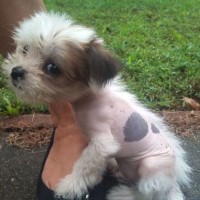Appearance of the Crested Tzu
|
| The Crested Tzu is a very small dog, generally measuring less than 30.5 centimeters in height and longer than tall, although length can vary a little from dog to dog. They have a slightly arched or domed head with a muzzle that can go anywhere from the tapered, tapering muzzle of the Chinese Crested Dog to the shorter, broader muzzle of the Shih Tzu, and brown eyes that can be round or almond-shaped. Thick-furred ears sit high on the sides of the head, and can either fold over or stand upright. The hairlessness of the Chinese Crested Dog is a dominant trait, and every Chinese Crested Dog carries both the dominant hairless gene and the recessive gene that produces the Powderpuff variety, which is entirely covered with a thick, silky double coat. Litters carrying two copies of the dominant gene are reabsorbed before they even have a chance to develop. This means that the coat coverage of this dog can range from full coverage to just the crest of the head, the plume of the tail and the socks of the hairless Chinese Crested Dog. Almost any coat color and many types of markings are possible with this crossbreed. |
Temperament of the Crested Tzu
|
| These small dogs tend to be extremely people-oriented and affectionate, preferring to be as close as possible to the human or humans of their choice. This hybrid can develop separation anxiety somewhat more often than many other types of dog, especially if left alone for too long. They are generally gentle by nature and not as yappy as most other toy breeds, although they may inherit a stubborn or wilful sequence from both parent breeds, which sometimes makes them a little more difficult to train as well as potty train. This hybrid will generally be very tolerant of other pets in the home, and will generally get along very peacefully. Although they are quite fond of well-behaved older children, the Crested Tzu may not be a suitable companion for very small or boisterous children, as there is a risk of jealous behavior from Crested Chinese Dog genetics, and rough or clumsy handling by the child can result in injury to the dog. |
Needs and activities of the Crested Tzu
|
| The Crested Tzu's exercise requirements are relatively undemanding, and are generally satisfied with forty to sixty minutes of brisk activity a day. Dividing these sessions into smaller chunks of time tends to be much more effective for these dogs. These small dogs are well suited to living in smaller spaces with several short walks or energetic indoor play sessions a day. In addition to indoor retrieving games, these small dogs are often well suited to other indoor activities such as hide-and-seek and puzzle toys, which serve to exercise both the dog's body and mind. Crested Tzu dogs are generally calm and make pleasant, polite housemates, making them an appropriate choice for apartment living. |
Maintenance of the Crested Tzu
|
| Grooming requirements for this breed can vary considerably depending on the type and amount of fur inherited by the dog in question. Crested Tzu dogs that are mostly hairless generally require frequent bathing, but brushing or combing after bathing usually takes only a few minutes, while the full-coated variety generally requires fewer baths, but the daily brushing routine will take a little longer. The skin of the Chinese Crested Dog is prone to irritation, especially in the hairless variety, and the Crested Tzu can also inherit this trait. It's essential to use a good, non-irritating dog shampoo when washing your dog, and to look for any problems such as rashes, acne or swollen skin every time you bathe him. These dogs can also be predisposed to dental infections and injuries due to the shape and size of their mouths, so it's of the utmost importance to get them used to dental examinations and ensure that their mouths are as clean and healthy as possible. |









 English (United Kingdom)
English (United Kingdom)